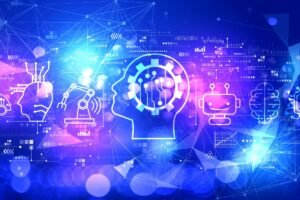Discover how Graph Neural Networks (GNNs) are transforming industries like drug discovery and materials science, accelerating research and unlocking new possibilities for innovation.
Table of Contents
Introduction
In the world of artificial intelligence (AI), we are all familiar with technologies that analyze images. These systems can easily differentiate between objects like cats and dogs in pictures, thanks to deep learning. But what happens when the data you are working with isn’t a neat image? What if it’s a complex network of relationships, like molecules or materials? Well, that’s where Graph Neural Networks (GNNs) come into play.
Graph Neural Networks are changing the way we understand complex systems, especially in fields like drug discovery, materials science, and chemistry. They allow us to model relationships between entities (like atoms) in a way that traditional methods can’t. So, let’s dive into how GNNs work and why they are such a game-changer.
What Are Graph Neural Networks (GNNs)?
A Graph Neural Network is a type of deep learning model designed to work with graph data. This data is structured as nodes (representing entities) connected by edges (representing relationships). Imagine a graph where each node is an atom in a molecule, and the edges are the bonds between them. The strength of GNNs lies in their ability to analyze the relationships between the nodes, helping to understand the interactions between different components of a system.
In simpler terms, GNNs allow AI to work with complex data that isn’t just about isolated objects but instead focuses on the relationships and dependencies between them. This makes them perfect for fields like materials science or drug discovery, where understanding interactions at a molecular level is critical.
Read More Transforming AI with Neural Architecture Search in 2025
How Do Graph Neural Networks Work?
Think of GNNs as a method for simulating how things work in the real world down to the resolution of a single atom. Let’s break it down.
- Nodes: These represent entities in your system. For a molecule, these could be atoms.
- Edges: These are the connections (bonds) between the nodes.
- Node Features: Each node can have information, like the type of atom it represents (e.g., hydrogen, oxygen, carbon).
- Edge Features: Similarly, edges can carry information about the type of bond between atoms (single, double, etc.).
What’s amazing about GNNs is their ability to “see” and understand how atoms interact with one another in a networked structure. The network learns from the local environment around each atom (node), allowing it to predict the properties of the entire molecule or material.
GNNs in Drug Discovery and Materials Science
One of the most exciting applications of GNNs is in drug discovery and materials science. Here’s why:
- Predicting Molecular Properties: Before a new molecule is synthesized in a lab, scientists can use GNNs to predict its properties. For example, they can simulate how well a molecule might bind to a receptor in the human body, which is crucial in developing new medications.
- Designing New Materials: GNNs can also help design new materials with specific properties, like stability, conductivity, or strength. For example, researchers could simulate and test various molecular structures in a digital environment, saving time and resources that would otherwise be spent on physical experiments.
Why Are GNNs Better than Traditional Methods?
Traditional methods for simulating molecular behavior are often computationally expensive and time-consuming. GNNs, on the other hand, can perform these tasks much faster and with greater accuracy. Here’s why:
- Iterative Learning: GNNs learn by iterating over a graph’s nodes and edges. Each time, they refine their understanding of how the system works, considering the local environment of each node.
- Scalability: GNNs can handle large, complex graphs, which is vital when working with complex molecules or materials that involve thousands of atoms and interactions.
The Future of GNNs
The potential of GNNs isn’t limited to drug discovery or materials science. They are transforming many industries by allowing us to understand complex systems with intricate relationships. This could mean breakthroughs in energy systems, transportation networks, and even climate modeling.
With AI’s ability to learn patterns from data, GNNs help accelerate the discovery of new materials, optimize networks, and enhance decision-making in various fields. The era of Graph Neural Networks has just begun, and it’s a thrilling time for researchers and industries alike.
Read More Understanding Prior-Fitted Networks (PFNs) and Bayesian Inference in Deep Learning
FAQs About Graph Neural Networks
Q. What are the main applications of GNNs?
Ans. GNNs are primarily used in drug discovery, materials science, and network optimization. They help scientists and engineers model complex systems and predict the properties of molecules, materials, and networks.
Q. How do GNNs differ from other AI models?
Ans. Unlike traditional AI models that focus on isolated data points (like pixels in an image), GNNs are designed to work with graph data, where relationships and interactions between entities are crucial.
Q. Can GNNs be used outside of science and technology?
Ans. Yes! While they’re most commonly used in scientific fields, GNNs are also useful for problems in social networks, finance, and transportation, where relationships and connections between entities play a significant role.
Conclusion
Graph Neural Networks are an exciting advancement in AI technology, offering unparalleled capabilities in understanding complex systems. Whether it’s designing new drugs, simulating materials, or optimizing networks, GNNs have the power to transform industries and accelerate innovation in ways we have never seen before.
As the world of AI continues to evolve, GNNs are paving the way for breakthroughs that could change everything from healthcare to the environment. The future is here, and it’s powered by Graph Neural Networks.





Pingback: Understanding Self-Supervised Learning in 2025
Pingback: Comprehensive Guide to Text Classification in NLP 2025